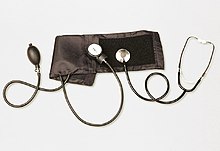Blood pressure monitor
A blood pressure monitor (also blood pressure monitor and sphygmomanometer ) is a measuring device with which the arterial pressure of a person can be measured externally, on the upper arm or on the wrist (see blood pressure measurement ). Arterial blood pressure values are usually given in the non- SI-compliant unit millimeter of mercury (mmHg or Torr). The measuring devices, which operate according to different methods, show the upper ( systolic ) and lower ( diastolic ) arterial pressure with different degrees of accuracy.
Classic blood pressure monitor (sphygmomanometer)
The classic arterial pressure measurement is carried out with mechanical devices on the upper arm. An analog pressure gauge and a rubber ball are attached to a cuff , connected via hoses . The pressure cuff is placed on the upper arm, directly above the elbow, and inflated with the rubber ball. When the patient is released slowly, swirling noises occur ( Korotkow noises ), which can be used to determine the systolic and diastolic arterial pressure values with the aid of a stethoscope (auscultatory measurement).
The blood pressure measured with the cuff on the upper arm and palpation of the pulse "according to Riva-Rocci " is abbreviated as "RR" (Riva-Rocci). In the course of time, the measurement technology was improved by supplementing the analog pressure gauge with electronic measuring sensors, which made the stethoscope unnecessary and could also record other data such as pulse rate.
Digital blood pressure monitor
Modern, electronic blood pressure monitors measure arterial pressure more or less automatically.
Measurement on the wrist
The commercially available measuring devices measure the arterial pressure on the inside of the wrist and are easy to use. The measuring device and cuff form a unit. The device is placed on the inside of the wrist, on the artery , and fastened with the cuff. After the start of the measurement, the cuff is inflated to an initial measurement pressure by an electric pump until no more blood can flow through the artery. An electrically controlled valve gradually reduces the pressure in the cuff. Sensors record the current pressure and the changing blood flow sounds. The device registers the points of the systolic and diastolic arterial blood pressure through pattern recognition . In addition, other key figures such as B. pulse rate , cardiac arrhythmias are recorded and an overall assessment status can be determined.
The measured blood pressure depends heavily on the relative measurement height - especially on the position of the cuff due to the arm position. It is therefore the rule to keep the cuff as close to your heart as possible. 1 cm blood column / measuring height corresponds to a pressure change of about 0.75 mmHg . If you held it at navel height, you would measure about 20 mmHg more pressure.
Measurement on the upper arm
Modern upper arm measuring devices show the values on an integrated screen. The cuff can be separated from the measuring device to allow different cuff sizes. They are less user-friendly than measuring devices with measurements on the inside of the wrist and are more expensive. But the accuracy of the measurement results speaks for them.
Measurement on the finger
The finger blood pressure monitors that were on the market a few years ago are practically no longer available. The measurement accuracy was not sufficient because the "measurement results depend too much on the blood circulation in the finger". An approximately correct average value could only be determined by repeated measurements. The electrically inflatable cuff, usually placed over the index finger, was also only suitable for certain finger strengths. Similar devices are now used purely for pulse measurement .
Classification as a medical product
A blood pressure monitor is a medical device . Medical devices work on or in the body without interfering with the human metabolism. According to the Medical Devices Act, they are divided into the following product classes:
- Class I: lowest risk class; this includes classic blood pressure monitors (sphygmomanometers)
- Class IIa: application risk; this includes digital blood pressure monitors
For the classification, it is crucial where the product is used (on the skin or in the body), how long it remains there and how it is operated (e.g. with electricity).
swell
Web links
Individual evidence
- ↑ Directive 93/42 / EEC (PDF)


